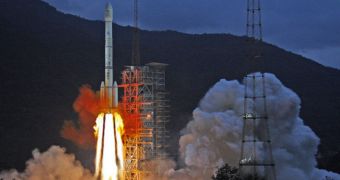Just a short while after launching its second unmanned probe headed for the Moon, the Chinese National Space Administration (CNSA) announced impressive development plans for the future.
The Communist nation plans to construct its own space station by no later than 2020, and to send a spacecraft, most likely an orbiter, to the Red Plane. Given its rapid pace of technological development, such plans are not an exaggeration, and not at all unfeasible.
In fact, the country has taken such a vested interest in space that many analysts in the field are beginning to speak about the end of US superiority and leadership in space.
And the rise of the CNSA and its program couldn't have come at a better moment in the current international context, they added. Such plans are announced precisely when the US space program is on the rocks, and the country is seeking to delegate space travel responsibilities to the private sector.
“Certainly [China] see it as an opportunity to garner prestige at a time when the US space program is in what some people call turmoil, and what others call regrouping,” explains Joan Johnson-Freese.
Even amidst the US general public, “there is the perception that China is somehow getting ahead, that the U.S. is sliding behind,” added the scientist, who is an expert on the Asian nation's space program.
Johnson-Freese holds an appointment as the chairwoman of the Department of National Security studies at the Naval War College, in Newport, Rhode Island.
The development of the CNSA largely came as a shock to the rest of the world. The US and the Soviet Union (and later the Russian Federation) have been active in space since the end of World War II.
They raced to send artificial satellites, animals and astronauts to orbit first, and to put people on the Moon. China only had its first manned spaceflight in 2003.
In seven years, it put three crews in orbit, carried out its first spacewalk, launched two lunar orbiters, and plans to demonstrate orbital docking capabilities in 2011. This is indeed great progress.
Once docking is achieved, the country will start using its Shenzhou space capsules to create an orbital facility. The spacecraft will be sent to low-Earth orbit using the Long March delivery system family.
The Asian nation is currently still ecstatic about the successful launch of the Chang'e 2, the second robotic Moon orbiter. A third spacecraft of the Chang'e series is scheduled to launch in 2013.
“The success of Chang'e 2 in accomplishing its mission marks another great achievement after the country successfully launched its first lunar probe,” said the Chinese Vice Premier Zhang Dejiang.
“The Chinese people will unswervingly develop technologies for the exploration of deep space and the peaceful use of outer space,” the official Xinhua news agency reports, quoted by Space.
According to analysts, China's main goal is to put people on the Moon, even if it's not willing to admit that publicly just yet.
“They're very conservative about laying out their goals. They have not announced an official manned lunar program. They want to have all the building blocks in place for success before that's announced,” Johnson-Freese explains.
She adds that the country launched 14 rockets this year, delivering Beidou satellites for its own satellite navigation system, as well as several Yaogan military satellites.
“To the rest of the world, China's working very eagerly and aggressively. Canada, Europe and Russia are all banging on the door for China to work with them,” the expert adds.
“I certainly have a concern that the US is going to end up the odd man out in terms of the globalization of space,” she concludes.

 14 DAY TRIAL //
14 DAY TRIAL //